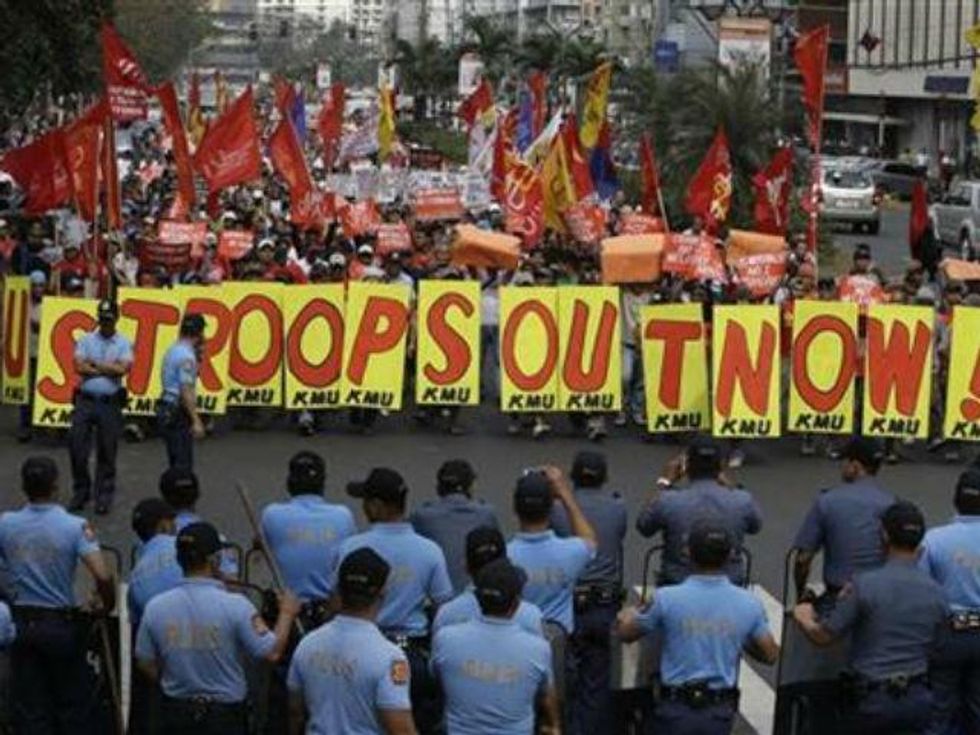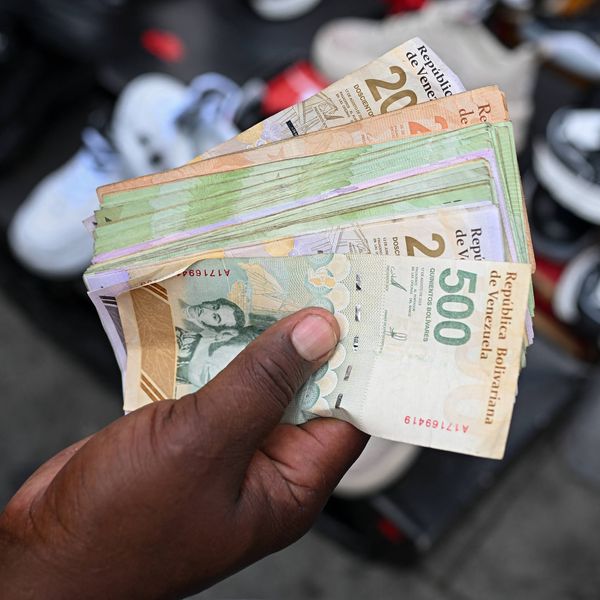'US Troops Out Now': Philippine Protesters Push Against Base Expansion
Hundreds march against Philippine government's cooperation with US bid for heavier military presence

"Aquino is desperately trying to outdo previous Philippine presidents when it comes to puppetry to the US," said Elmer "Bong" Labog, spokesperson for labor organization Kilusang Mayo Uno (May First Movement), which organized the demonstration.
Riot police clashed with approximately 300 demonstrators, who carried signs and banners that read "Obama Not Welcome" and "US Troops Out Now," near the U.S. embassy in Manila. At one point police attacked the crowd with truncheons, but no one was seriously injured, the Associated Press reports.
The protest comes ahead of a planned visit by U.S. President Barack Obama in April, which will be aimed at making progress towards an agreement over sustained U.S. military presence in the Philippines, including in the Subic Bay, which overlooks the South China Sea.
Social movements in the Philippines have long opposed U.S. power over their country, which includes more than five decades of direct colonial rule and the backing of brutal dictator Ferdinand Marcos -- who was president from 1965 to 1986 until he was overthrown by a popular movement. Even after Philippine independence, the U.S. maintained a heavy presence of bases and troops, despite widespread opposition to the environmental and social harm they spread, including numerous incidents of sexual assaults and rape of the local population.
While the last U.S. base in the country was shut down in 1992, the U.S. currently sends 500 troops to the southern Philippines annually for so-called counter-terrorism purposes, while 6,500 come each year for training, according to the Philippine military.
With the cooperation of Aquino, Obama is aggressively pushing to expand this military presence as part of the U.S. military's pivot to Asia to hedge against China. The U.S. and Philippine governments have levied U.S. humanitarian response to Typhoon Haiyan to build support for a deal.
According to Labong, Aquino "tries to make it appear that the return of US military bases to the Philippines is part of efforts to help the country when it is part of the U.S. geopolitical strategy."
_____________________
An Urgent Message From Our Co-Founder
Dear Common Dreams reader, The U.S. is on a fast track to authoritarianism like nothing I've ever seen. Meanwhile, corporate news outlets are utterly capitulating to Trump, twisting their coverage to avoid drawing his ire while lining up to stuff cash in his pockets. That's why I believe that Common Dreams is doing the best and most consequential reporting that we've ever done. Our small but mighty team is a progressive reporting powerhouse, covering the news every day that the corporate media never will. Our mission has always been simple: To inform. To inspire. And to ignite change for the common good. Now here's the key piece that I want all our readers to understand: None of this would be possible without your financial support. That's not just some fundraising cliche. It's the absolute and literal truth. We don't accept corporate advertising and never will. We don't have a paywall because we don't think people should be blocked from critical news based on their ability to pay. Everything we do is funded by the donations of readers like you. Will you donate now to help power the nonprofit, independent reporting of Common Dreams? Thank you for being a vital member of our community. Together, we can keep independent journalism alive when it’s needed most. - Craig Brown, Co-founder |

"Aquino is desperately trying to outdo previous Philippine presidents when it comes to puppetry to the US," said Elmer "Bong" Labog, spokesperson for labor organization Kilusang Mayo Uno (May First Movement), which organized the demonstration.
Riot police clashed with approximately 300 demonstrators, who carried signs and banners that read "Obama Not Welcome" and "US Troops Out Now," near the U.S. embassy in Manila. At one point police attacked the crowd with truncheons, but no one was seriously injured, the Associated Press reports.
The protest comes ahead of a planned visit by U.S. President Barack Obama in April, which will be aimed at making progress towards an agreement over sustained U.S. military presence in the Philippines, including in the Subic Bay, which overlooks the South China Sea.
Social movements in the Philippines have long opposed U.S. power over their country, which includes more than five decades of direct colonial rule and the backing of brutal dictator Ferdinand Marcos -- who was president from 1965 to 1986 until he was overthrown by a popular movement. Even after Philippine independence, the U.S. maintained a heavy presence of bases and troops, despite widespread opposition to the environmental and social harm they spread, including numerous incidents of sexual assaults and rape of the local population.
While the last U.S. base in the country was shut down in 1992, the U.S. currently sends 500 troops to the southern Philippines annually for so-called counter-terrorism purposes, while 6,500 come each year for training, according to the Philippine military.
With the cooperation of Aquino, Obama is aggressively pushing to expand this military presence as part of the U.S. military's pivot to Asia to hedge against China. The U.S. and Philippine governments have levied U.S. humanitarian response to Typhoon Haiyan to build support for a deal.
According to Labong, Aquino "tries to make it appear that the return of US military bases to the Philippines is part of efforts to help the country when it is part of the U.S. geopolitical strategy."
_____________________

"Aquino is desperately trying to outdo previous Philippine presidents when it comes to puppetry to the US," said Elmer "Bong" Labog, spokesperson for labor organization Kilusang Mayo Uno (May First Movement), which organized the demonstration.
Riot police clashed with approximately 300 demonstrators, who carried signs and banners that read "Obama Not Welcome" and "US Troops Out Now," near the U.S. embassy in Manila. At one point police attacked the crowd with truncheons, but no one was seriously injured, the Associated Press reports.
The protest comes ahead of a planned visit by U.S. President Barack Obama in April, which will be aimed at making progress towards an agreement over sustained U.S. military presence in the Philippines, including in the Subic Bay, which overlooks the South China Sea.
Social movements in the Philippines have long opposed U.S. power over their country, which includes more than five decades of direct colonial rule and the backing of brutal dictator Ferdinand Marcos -- who was president from 1965 to 1986 until he was overthrown by a popular movement. Even after Philippine independence, the U.S. maintained a heavy presence of bases and troops, despite widespread opposition to the environmental and social harm they spread, including numerous incidents of sexual assaults and rape of the local population.
While the last U.S. base in the country was shut down in 1992, the U.S. currently sends 500 troops to the southern Philippines annually for so-called counter-terrorism purposes, while 6,500 come each year for training, according to the Philippine military.
With the cooperation of Aquino, Obama is aggressively pushing to expand this military presence as part of the U.S. military's pivot to Asia to hedge against China. The U.S. and Philippine governments have levied U.S. humanitarian response to Typhoon Haiyan to build support for a deal.
According to Labong, Aquino "tries to make it appear that the return of US military bases to the Philippines is part of efforts to help the country when it is part of the U.S. geopolitical strategy."
_____________________

